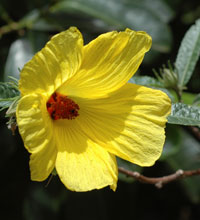Water Conservation Strategies at the ANBG
The need to use water and other resources in an environmentally responsible manner is embedded in the Australian National Botanic Gardens (ANBG) Management Plan 2002-08.
In line with these priorities, the ANBG has put in place a number of measures to conserve water since the recent drought and into the future.
Systematic audits
- Horticultural managers have been conducting systematic audits of irrigation performance across the approximately 20 hectares of developed site. This formal process began in July 2002 and involves detailed analysis of water outputs for each irrigation station and refinement and coordination of the scheduling of all irrigation systems, both automatic and manual. In addition the two water meters on the site are being monitored monthly to give fairly immediate feedback on our collective and continuing water use.
Computerised irrigation
- A new State of the art Computerised irrigation system has been installed. This allows us to manage our water usage from one point. It utilizes the latest software technology, integrating a weather station to supply the most accurate information in order to achieve optimum water efficiencies and sound management practices. We are able to extract reports to see what water has been applied to varying sections. This information can be utilised in order to match our water applications to natural rainfall occurring in the original provenance locations of the plants we maintain.
Reconfiguring irrigation systems
- Irrigation systems are being reconfigured as necessary to realise water savings. In appropriate places, gear driven sprinklers (that cannot be readjusted by visiting children) have replaced impact sprinklers that inevitably spray areas around them that do not require irrigation, such as roadways. Irrigation systems that apply water to steeply sloping beds are being split into upper and lower systems that take into account the natural seepage of water down slopes.
Night irrigation
- Currently around 85% of the irrigation of the Gardens is applied in the evening under preprogrammed automatic control. Further work will continue during the next 12 months to connect all non-automated areas to our existing controllers. This will allow us to irrigate during the night and reduce the need to water areas during the day.
Wetting agents
- Wetting agents are being used on lawns and gardens to aid with water penetration into the soil profile rather than having water run off the surface and into stormwater drains.
Monitoring lawns
- The lawn areas have received less water during the last four years than usual. We have turned the water off to certain lawn areas with a requirement to program lawn irrigation on an as need basis. This has allowed us to reduce lawn watering to approximately once a fortnight and to only apply water when the turf is showing high levels of stress.
Ponds and water features
- Some of the ponds and water features have been modified to become more efficient. Capital works to the Tasmanian pond diverted water from the rainforest into the Tasmanian pond. Previously water was piped underneath this pond into the storm water system. We no longer need to use potable water to ‘top up’ that pond system.
Shade cloths
- The new nursery has been designed to capture, treat and recycle water. In the existing nursery we have applied shade cloth to propagation benches in order to reduce the evaporation losses from plants growing below.
In the midst of these water conservation strategies, both short and long term, it must be remembered that the ANBG represents the combined effort and commitment of a large number of staff as well as the expenditure of a large amount of capital over many years, and it is a significant site for the people of Canberra and visitors from around Australia and the world.
We have identified areas where irrigation can be greatly reduced and even shut down with a list of some very important species within our collection that are held in these areas. We plan to monitor the soil moisture levels closely in these areas and apply irrigation when absolutely necessary, either by hand or programmed nightly irrigation, so that plant losses are minimal.
![Director of National Parks [logo]](../../../images/dnp_90px.gif)






